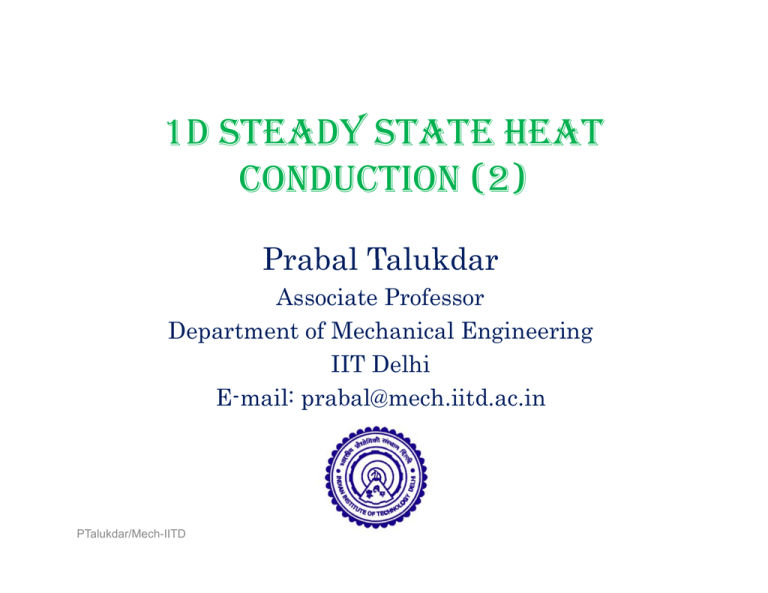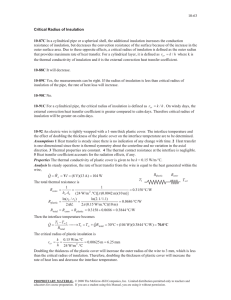Lecture note 6-7
advertisement

1D STEADY STATE HEAT CONDUCTION (2) Prabal Talukdar Associate Professor Department of Mechanical Engineering IIT Delhi E-mail: prabal@mech.iitd.ac.in p PTalukdar/Mech-IITD Thermal Contact Resistance Temperature distribution and heat flow lines along two solid plates pressed against each other for the case of perfect and imperfect contact PTalukdar/Mech-IITD Consider heat transfer through two metal rods of cross-sectional area A that are pressed against each other other. Heat transfer through the interface of these two rods is the sum of the heat transfers through the solid contact spots and the gaps in the noncontact areas and can be expressed as • • Q = Q Most experimentally determined Most experimentally determined values of the thermal contact resistance fall between 0.000005 and 0.0005 m2∙°C/W (the corresponding range of thermal contact conductance is 2000 to 200,000 W/m2∙°C). • contact + Q gap • Q = h c A Δ T int erface where A is the apparent interface area (which is the same as the crosssectional area of the rods) and ΔTinterface is the effective temperature difference at the interface. The quantity hc, which corresponds to the convection heat transfer coefficient, is called the thermal contact conductance and is expressed as • h c Q = Δ T (W/m2 oC) A int erface It is related to thermal contact resistance by R PTalukdar/Mech-IITD c = 1 h c = Δ T int • Q erface A (m2 oC/W) Importance of consideration Th th The thermall contact t t resistance i t range: between 0.000005 and 0.0005 m2·°C/W PTalukdar/Mech-IITD Two parallel layers • • Q = Q • 1 + Q 2 = T1 − T R1 2 + T1 − T R 2 2 = (T1 − T R1 = • Q = T1 − T R total ⎛ 1 1 ) ⎜⎜ + R 2 ⎝ R1 L1 k 1 A 1' R 2 = ⎞ ⎟⎟ ⎠ k L 2 2 A ' 2 2 where PTalukdar/Mech-IITD 2 1 R total = 1 1 + R1 R 2 R total = R1R 2 R1 + R 2 Combined series-parallel series parallel • Q = T1 − T R total ∞ R1 R 2 + R 3 + R conv R1 + R 2 R total = R 12 + R 3 + R conv = R1 = R conv L1 k 1 A 1' = 1 hA R 3 PTalukdar/Mech-IITD 2 = L k 2 2 A ' 2 R 3 = L k 3 3 A 3' Series and parallel composite wall and its thermal circuit RD RA R∞1 RC T∞1 ∑ R = R ∞1 + R∞2 RE T∞2 RF RB 1 ⎛ 1 1 ⎞ ⎜⎜ ⎟⎟ + ⎝ RA RB ⎠ + RC + 1 ⎛ 1 1 1 ⎞ ⎜⎜ ⎟⎟ + + ⎝ RD RE RF ⎠ + R ∞2 • Q = UA Δ T (W) where U is the overall heat transfer coefficient UA = PTalukdar/Mech-IITD 1 R total T1 T2 T3 T4 Complex multi-dimensional problems as 1-D problems 1 Any plane wall normal to the x-axis is isothermal 1. 2. Any plane parallel to x-axis is adiabatic PTalukdar/Mech-IITD Heat conduction in cylinder • Q cond ,cyl = − kA dT dr A = 2 π rL L • r ∫ r2= r 1 Q cond ,cyl A T dr = − ∫ T2=T kdT 1 Substituting A = 2πrL and performing the integrations give • Q cond ,cyl T − T2 = 2 πLk 1 ln( r2 r1 ) • Q cond , cyl PTalukdar/Mech-IITD = T1 − T 2 R cyl R cyl = • Q cond ,cyl =constant at steady state (W) ln( r2 r1 ) 2 πLk = ln(outer radius/inner radius) 2π(length)(thermal conductivity) Heat conduction in sphere T1 − T2 & Q = cond ,sphere R sph For sphere r −r Rsph = 2 1 4πr1r2k PTalukdar/Mech-IITD = outer radius - inner radius 4π(outer radius)(inner radius)(thermal conductivity) Resistance Network cylindrical R total = R conv ,1 + R cond + R conv , 2 = ln (r 2 r1 ) 1 1 + + (2 π r1 L )h 1 2 π Lk ( 2 π r2 L ) h 2 spherical R total = R conv = 1 (4 π r )h 1 The thermal resistance network for a cylindrical (or spherical) shell subjected to convection from both the inner and the outer sides. PTalukdar/Mech-IITD 2 + 1 ,1 + R sph + R conv ,2 r 2 − r1 1 + 4 π r1 r 2 k ( 4 π r2 2 ) h 2 Multilayered cylinder R total = R conv ,1 + R cyl ,1 + R cyl , 2 + R cyl , 3 + R conv , 2 = PTalukdar/Mech-IITD ln (r 2 r1 ) ln (r 3 r 2 ) ln (r 4 r 3 ) 1 1 + + + + h 1A 1 2 π Lk 1 2 π Lk 2 2 π Lk 3 h 2A 4 Radial heat conduction through cylindrical systems 1 ∂ ⎛ ∂T ⎞ 1 ∂ ⎛ ∂T ⎞ ∂ ⎛ ∂T ⎞ ∂T ⎜⎜ k.r ⎟⎟ + ⎜ k. ⎟ + g& = ρC ⎜ k.r ⎟+ 2 ∂r ⎠ r ∂φ ⎝ ∂φ ⎠ ∂z ⎝ ∂z ⎠ ∂t r ∂r ⎝ d ⎛ dT ⎞ ⎜r ⎟=0 dr ⎝ dr ⎠ Integrating the above equation twice twice, T=C1ln r + C2 Subject to the boundary conditions, T=T1 at r = r1 and T=T2 at r = r2 T = T 2 − T1 T ln r 2 − T 2 ln r1 ln (r ) + 1 ⎛r ⎞ ⎛r ⎞ ln ⎜⎜ 2 ⎟⎟ ln ⎜⎜ 2 ⎟⎟ ⎝ r1 ⎠ ⎝ r1 ⎠ PTalukdar/Mech-IITD C1 ddT Q = − kA r |r = r1 = − k.2πr1L. dr r1 Q = − k.2πr1L.(T2 − T1 ). = 2πkL(T1 − T2 ) ⎛ r2 ⎞ ln⎜⎜ ⎟⎟ ⎝ r1 ⎠ PTalukdar/Mech-IITD 1 ⎛r r1 ln⎜⎜ 2 ⎝ r1 ⎞ ⎟⎟ ⎠ Critical Radius of Insulation 1. Steady state conditions 2. One-dimensional heat flow only in the radial direction 3. Negligible thermal resistance due to cylinder wall 4 Negligible radiation exchange 4. between outer surface of insulation and surroundings PTalukdar/Mech-IITD Insulation r2 T∞ , h r1 Thin wall Ts Critical Radius of Insulation • • Practically, it turns out that adding insulation in cylindrical and spherical exposed p walls can initiallyy cause the thermal resistance to decrease,, thereby y increasing the heat transfer rate because the outside area for convection heat transfer is getting larger. At some critical thickness, rcr, the thermal resistance increases again and consequently the heat transfer is reduced. To find an expression for rcr, consider the thermal circuit below for an insulated cylindrical wall with thermal conductivity k: & T1 Q Insulation r2 T∞ , h r1 PTalukdar/Mech-IITD Thin wall Ts Ts ln(r2 r1 ) 2πk Rt ’ T∞ 1 2πr2h An insulated cylindrical pipe exposed to convection from the outer surface and the thermal resistance network associated with it. PTalukdar/Mech-IITD • To find rcr, set the overall thermal resistance dRt’/dr = 0 and solve for r: R′t = ln(r ri ) 1 + 2πk 2πrh ri = inner radius dR′t 1 1 = − =0 2 dr 2πkr 2πr h k r = rcr = h Similarly for a sphere 2k rcr = h • For For insulation thickness less that r insulation thickness less that rcr the heat loss increases the heat loss increases with increasing r and for insulation thickness greater that rcr the heat loss decreases with increasing r • If k = 0.03 W/(m∙K) and h = 10 W/(m2∙K): k 0.03 W/(m·K) = 0.003m = 3mm – cylinder rcr = = 2 h 10 W/(m ( ·K)) 2k = 6mm – sphere rcr = PTalukdar/Mech-IITD h Values of r1, h and k are constant To see the condition maximizes or minimizes the total resistance d 2 R total dr2 2 =− 1 2πkr22 + 1 πr23 h At r2=k/h Total thermal resistance per unit length d 2 R total ⎛r ⎞ ln⎜⎜ 2 ⎟⎟ r 1 = ⎝ 1⎠+ 2πk 2πr2 h dr2 2 R total Heat transfer p per unit length g 1 ⎛1 1 ⎞ − ⎟= >0 ⎜ 2 k 2k 3 2 ⎠ 2πk h π(k h ) ⎝ 1 Always positive, total resistance at k/h is minimum • Q T∞ − Ti = L Rtotal Optimum thickness is associated with r2, dRtotal 1 1 − =0 2πkr2 2πr22 h = dr2 r2 = k h rcr ,cylinder = =0 k h (m) rcr , max = k max, insulation h min ≈ ( 0 .05 W m o C ( 5 W m 2o C ) ) = 0.01m = 1cm We can insulate hot water pipes and steam lines without worrying the critical radius of insulation Insulation of electric wires: -Radius of electric wires may be smaller than the critical radius -Addition Addition of insulation material increases heat transfer Critical radius of insulation for spherical shell: rcr ,sphere = 2k h Summary • Table 3.3 Table 3 3 PTalukdar/Mech-IITD 1D Conduction with Heat Generation PTalukdar/Mech-IITD • 2 d T q + = 0 2 dx k • T (x ) = − q 2 x + C1x + C 2 2k Boundaryy conditions: T (− L ) = T s ,1 T (L ) = T s , 2 • qL 2 T (x) = 2k PTalukdar/Mech-IITD C1 = T s , 2 − T s ,1 • C 2 2L T s , 2 + T s ,1 q 2 = L + 2k 2 T s , 2 + T s ,1 ⎛ x 2 ⎞ T s , 2 − T s ,1 x ⎜⎜ 1 − 2 ⎟⎟ + + 2 2 L ⎠ L ⎝ Ts ,1 = Ts , 2 ≡ Ts • qL 2 T (x) = 2k ⎛ x2 ⎞ ⎜⎜ 1 − 2 ⎟⎟ + T s L ⎠ ⎝ • qL L2 T (0) ≡ To = + Ts 2k Put x = 0 If the surface temperature of the heat generating body is unknown and the surrounding fluid temperature is T∞ Find temperature gradient dT | x = L = h(Ts − T∞ ) • from the above Eq. Using g energy gy balance − k q at x = L d dx We can obtain the surface temperature PTalukdar/Mech-IITD qL Ts = T∞ + h • 1 d ⎛ dT ⎞ q ⎟+ = 0 ⎜r r dr ⎝ dr ⎠ k • dT q r2 r =− + C1 d dr 2k • q r2 T (r ) = − + C 1 ln r + C 2 4k • Boundary conditions: dT |r = 0 = 0 dr T ( ro ) = T s • • C1 = 0 PTalukdar/Mech-IITD q ro T (r ) = 4k C 2 = Ts + q ro 4k 2 ( 2 ⎛ r2 ⎞ ⎜⎜ 1 − 2 ⎟⎟ + T s ro ⎠ ⎝ ) q Π ro2 L = h ( 2 Π ro L )( T s − T ∞ ) • q ro Ts = T∞ + 2h


